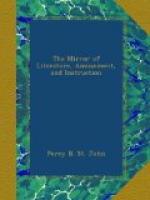Preservation of Canvass.
The Literary Gazette informs us, that an inhabitant of Troyes, in Champagne, has discovered a method of preparing canvass, and every other description of coarse linen, so as to resist damp, and prevent the approach of insects and vermin, and that the inventor promises to make his discovery public.
Bacon.
An American journal says, that Elder leaves bruised in a mortar, with a little water, will destroy skippers in bacon, without injuring the meat.
Ale.
Ale brewers usually put into the bung-hole of each cask, when stowed away, a handful of half boiled hops impregnated with wort, the object of which is to exclude the atmospheric air by covering the surface of the liquid; but some brewers, more rigidly attentive, insert (privately) at the same time, about one ounce of powdered black rosin, previously mixed with beer, which swims on the surface, but after a time is partially absorbed.—Lib. Useful Know.
Beer Poisons.
Cocculus Indicus is largely imported into this country, considering that few know for what other purpose it is used than to adulterate beer. We suspect what was at one time generally sold to brewers for Cocculus Indicus was really Nux Vomica (used to poison rats), and that the brewers’ druggists when making their defence, passed Nux Vomica for Cocculus Indicus, on the same principle as the forgers of bank notes plead guilty to the lesser indictment. Opium, we believe, is still in use; for we have known seizures of that article in the custody of ale brewers, within the last two years.—Library of Useful Know.
Bees.
A Correspondent of the Magazine of Natural History, says, “the superstition respecting bees prevails in some parts, as to informing them of any great public event that takes place.”
Swan River Settlement.
The soil of Swan River, from its moist state, is better adapted to the cultivation of tobacco and cotton than any other part of Australia. Both these articles are intended to be cultivated on a large scale, as also sugar and flax, with various important articles of drugs that the climate is peculiarly adapted to the growth of.—Parliamentary Papers.
The Harvest Bug
Is so minute as to be visible only to the keenest eyes, and then only when on any very smooth white surface. Ladies and children are the first to complain of their attacks; and chiefly where any part of the dress fits closely to the skin. There they seat themselves at the intersection of the lines, and lay such firm hold with their feet and jaws, that they cannot be displaced by rubbing, nor by washing, unless a powerful spirit or acid be used. By a microscope, the bug will be seen to have eight legs, two feelers, and an abdomen something egg-shaped; colour livid red; and in size no bigger than the point of a small needle. They lacerate the epidermis in some way or other, as a small hole is observable where they have been seated; and cause extreme itching and considerable inflammation of the part.—Magazine of Natural History.




